Written Records, AWM54 741/5/9 PART 2 - [Patrols - Reconnaissance:] Report on Northern Territory Special Reconnaissance Unit, by Sqn Ldr D F Thomson RAAF [Report minus maps] - Part 9
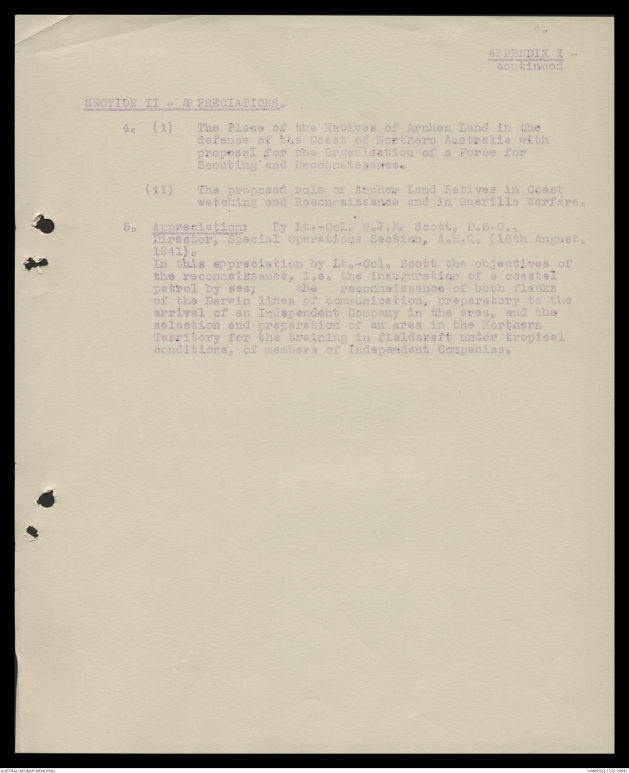
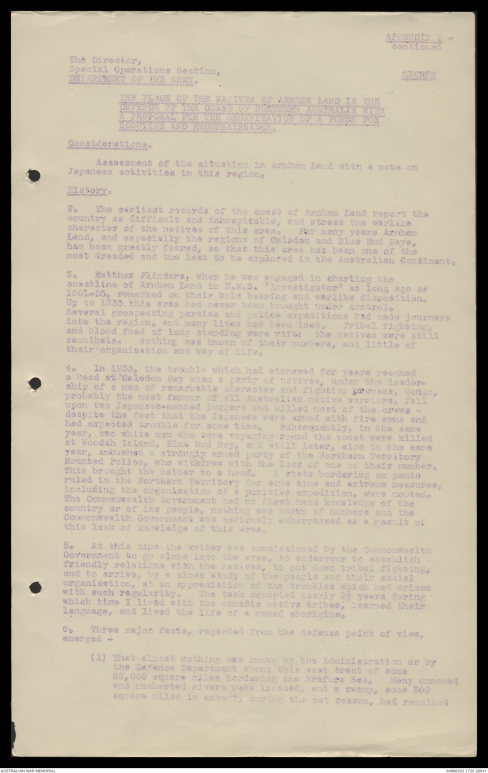

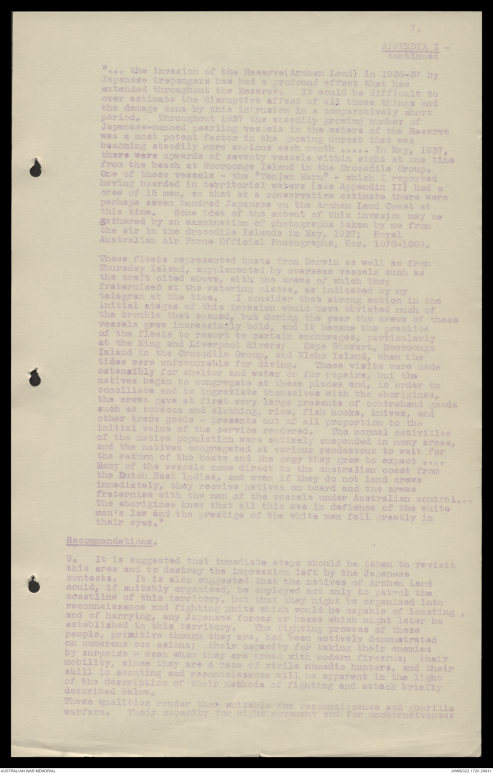
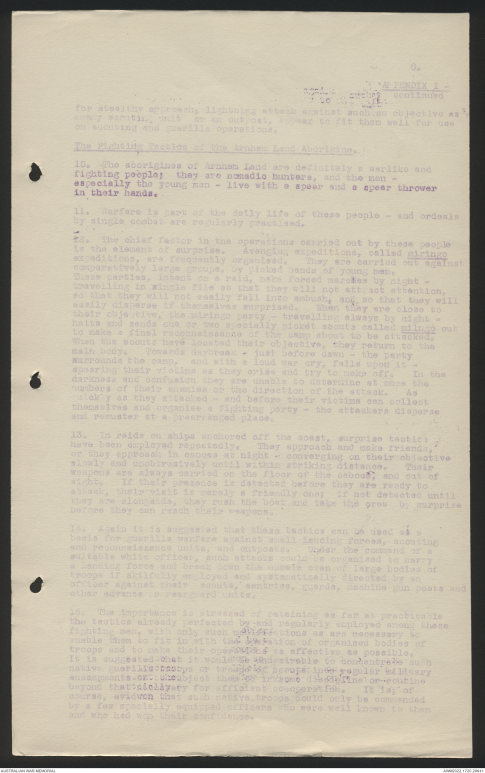


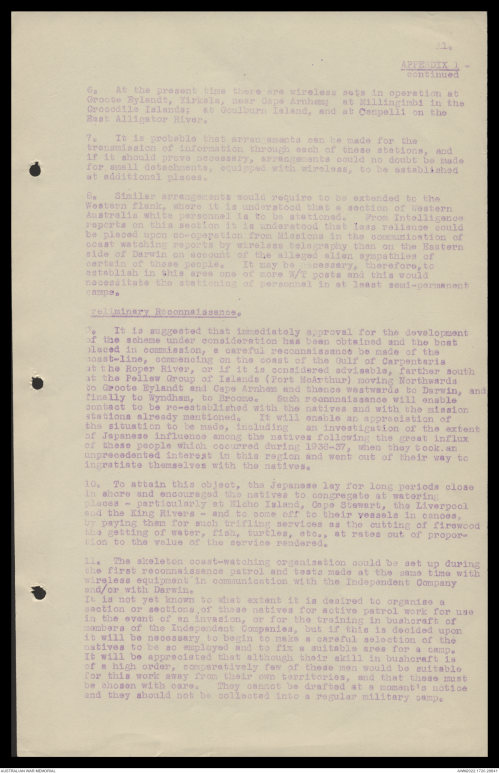
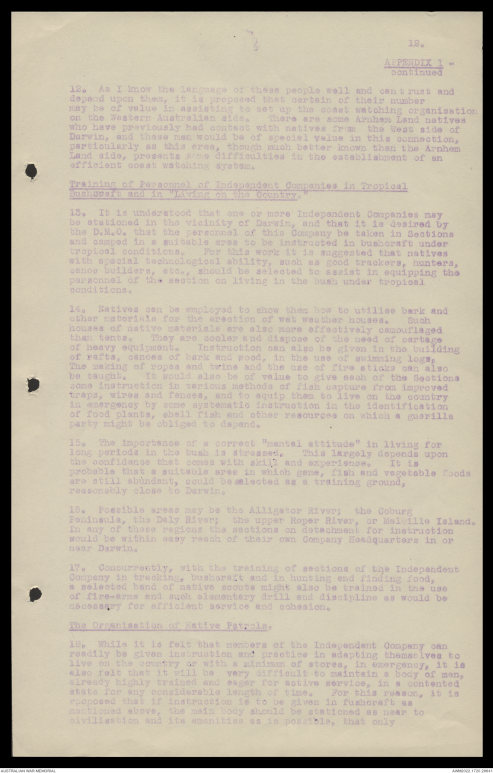
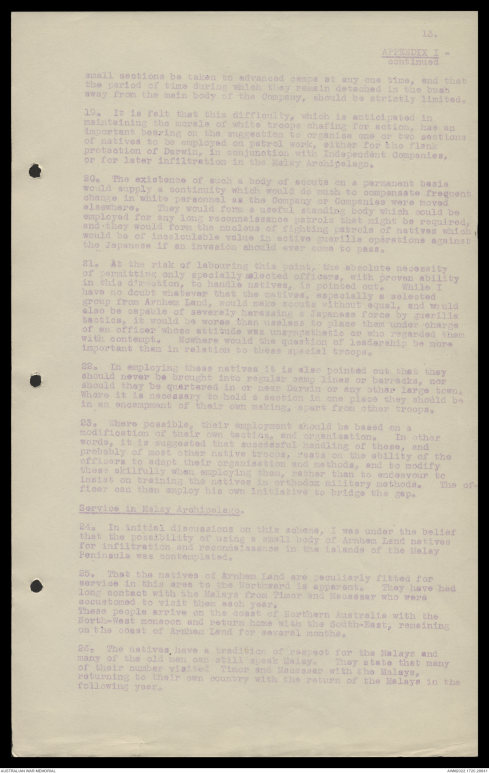
4.
APPENDIX I -
continued
SECTION II - APPRECIATIONS.
4. (i) The Place of the Natives of Arnhem Land in the
defence of the Coast of Northern Australia with
proposal for the Organisation of a Force for
Scouting and Reconnaissance.
(ii) The proposed role of Arnhem Land Natives in Coast
watching and Reconnaissance and in Guerilla Warfare.
5. Appreciation: By Lt.-Col. W.J.R. Scott, D.S.O.,
Director, Special Operations Section, A.H.Q. (16th August,
1941).
In this appreciation by Lt.-Col. Scott the objectives of
the reconnaissance, i.e. the inauguration of a coastal
patrol be sea; the reconnaissance of both flanks
of the Darwin lines of communication, preparatory to the
arrival of an Independent Company in the area, and the
selection and preparation of an area in the Northern
Territory for the training in fieldcraft under tropical
conditions, of members of Independent Companies.
APPENDIX I -
continued
The Director,
Special Operations Section,
DEPARTMENT OF THE ARMY. URGENT
THE PLACE OF THE NATIVES OF ARNHEM LAND IN THE
DEFENCE OF THE COAST OF NORTHERN AUSTRALIA WITH
A PROPOSAL FOR THE ORGANISATION OF A FORCE FOR
SCOUTING AND RECONNAISSANCE.
CONSIDERATIONS.
Assessment of the situation in Arnhem Land with a note on
Japanese activities in this region.
History.
2. The earliest records of the coast of Arnhem Land report the
country as difficult and incompatible, and stress the warlike
character of the natives of this area. For many years Arnhem
Land, and especially the regions of Caledon and Blue Mud Bays,
has been greatly feared, so that this area has bee one of the
most dreaded and the last to be explored in the Australian Continent.
3. Matthew Flinders, when he was engaged in charting the
coastline of Arnhem Land in H.M.S. "Investigator" as long ago as
1801-03, remarked on their bold bearing and warlike disposition.
Up to 1933 this are had never been brought under control.
Several prospecting parties and police expeditions had made journeys
into the region, and many lives had been lost. Tribal fighting,
and blood feud of long standing were rife, the natives were still
cannibals. Nothing was known of their numbers, and little of
their organisation and way of life.
4. In 1933, the trouble which had simmered for years reached
a head at Caledon Bay when a party of natives, under the leadership
of a man of remarkable character and fighting prowess, Wengo,
probably the most famous of all Australian native warriors, fell
upon two Japanese-manned luggers and killed most of the crews -
despite the fact that the Japanese were armed with fire arms and
had expected trouble for some time. Subsequently, in the same
year, two white men who were voyaging round the coast were killed
at Woodah Island, Blue Mud Bay, and still later, also in the same
year, ambushed a strongly armed party of the Northern Territory
Mounted Police, who withdrew with the loss of one of their number.
This brought the matter to a hand. A state bordering on panic
ruled in the Northern Territory for some time and extreme measures,
including the organisation of a punitive expedition, were mooted.
The Commonwealth Government had no first hand knowledge of the
country or of the people, nothing was known of numbers and the
Commonwealth Government was seriously embarrassed as a result of
this lack of knowledge of this area.
5. At this time the writer was commissioned by the Commonwealth
Government to go alone into the area, to endeavour to establish
friendly relations with the natives, to put down tribal fighting,
and to arrive by a close study of the people and their social
organisation, at an appreciation of the troubles which had arisen
with such regularity. The task occupied nearly 2 ½ years during
which time I lived with the nomadic native tribes, learned their
language, and lived the life of a nomad aborigine.
6. Three major facts, regarded from the defense point of view,
emerged -
(1) That almost nothing was known by the Administration or by
the Defence Department about this vast tract of some
25,000 square miles bordering the Arafura Sea. Many unnamed
and uncharted rivers were located, and a swamp, some 300
square miles in extent, during the wet season, had remained
APPENDIX I -
continued
unmapped on the Clyde River. It still remained in fact
a "no man's land."
(2) That despite the hostility of the natives towards their
race, as demonstrated by the Caledon Bay massacre and
by other incidents, the Japanese were interested in this
region when some hundreds of men were concentrated in
pearling and beche de mer luggers on the Northern coastline
for many months. Although these people were ostensibly
engaged in pearling, they took elaborate steps to
ingratiate themselves with the natives, and their efforts
in this direction were such as to create a profound
impression upon the minds of the natives. (See below,
quotation from Report to Commonwealth Government, 1930).
(3) That the natives of Arnhem Land had a long standing
association extending back probably for many centuries with
the people of the Malay Archipelago, who were accustomed
to making regular seasonal voyages to the coast of Arnhem
Land, arriving with the North-West monsoon and returning
home from Arnhem Land with the South-East.
There was a well established relationship between the
visitors from Indonesia and the Arnhem Land natives who
held their visitors in a respect that amounted to a hero
worship. The importance of this fact and the value of
this attitude towards the people of the Malay Archipelago
will be discussed later.
7. It is submitted that, as nothing has been done subsequently
to obtain knowledge of this country (except for recent serial
patrols which do not shed much light on ground conditions, water,
etc. etc.) this lack of knowledge of the coastline of Arnhem Land
and its hinterland constitute a real danger to Australia, and
secondly, that the extensive "penetration" of this area, and the
courting of the natives friendship by the crews of Japanese luggers,
which increased greatly during the period (1933-37) under review,
may not have been without significance. It cannot be too strongly
emphasised this (apparently) organised attempt on the part of the
Japanese to win the friendship of these people actually did much
to undermine the prestige of the white man, and that nothing has
since been done to counter this influence. It is further admitted
that this situation - this attitude towards the Japanese crews
constitutes a special hanger to the event of an attempt by the
Japanese to land troops or to establish advance operations bases
in Arnhem Land.
It is further pointed out that the regions at which the controls
were made with the Japanese - at watering places and safe anchorages
along the coast - are those at which landings might be expected in
the event of hostile operations against this country. Thirdly,
it is stressed that the traditional friendship of the natives
of Arnhem Land (which is so real and so extensive that it dominates
their mythology and much of their ceremonial life), amounting to
an attitude of "hero worship" for the people of the Malay Peninsula,
renders them peculiarly valuable for the tasks of scouting and
reconnaissance in the Malay Archipelago. It is evident that they
would readily establish themselves among these people with whom
they are already on a friendly footing and that they would be of
great value in infiltrating this area. This would, however,
occupy a considerable time and no time is to be lost in establishing
preliminary contacts with the aid of these people, and of assessing
the "attitude" towards Japanese and the degree of penetration they
have already been able to accomplish in their peering operations
in the Dutch and Portuguese Islands.
Japanese activities in Arnhem Land, 1937.
8. The following extract is taken from my report to the Commonwealth
Government made in 1936 -
7.
APPENDIX I -
continued
"... the invasion of the Reserve (Arnhem Land) in 1936-37 by
Japanese trapangers has had a profound effect that has
extended throughout the Reserve. It would be difficult to
over estimate the disruptive affect of all these things ad
the damage done by this intrusion in a comparatively short
period. Throughout 1937 the steadily growing number of
Japanese-manned pearling vessels in the waters of the Reserve
was a most potent fester in the growing unrest that was
becoming steadily more serious each month ..... In May, 1937,
there were upwards of seventy vessels within eight at one time
from the beach at Moorooka Island in the Crocodile Group.
One of these vessels - the "Tenjan Naru" - which I reported
having boarded in territorial waters (see Appendix II) had a
crew of 16 men, so that at a conservative estimate there were
perhaps seven hundred Japanese on the Arnhem Land Coast at
this time. Some idea of the extent of this invasion may be
gathered by an examination of photographs taken by me from
the air in the Crocodile Islands in May, 1937; Royal
Australian Air Force Official Photographs, Nos, [[1076-1099?]].
These fleets represented boats from Darwin as well as from
Thursday Island, supplemented by overseas vessels such as
the craft cited above, with the crews of which they
fraternised at the watering places, as indicated by my
telegram at the time. I consider that strong action in the
initial stages of this invasion would have obviated much of
the trouble that ensued, but during the year the crews of these
vessels grew increasingly bold, and it became the practice
of the fleets to resort to certain anchorages, particularly
at the King and Liverpool Rivers; Cape Stewart, Moorooka
island in the Crocodile Group, and Elcho Island, when the
tides were unfavourable for diving. These visits were made
ostensibly for shelter and water or for repairs, but the
natives began to congregate at these places and, in order to
conciliate and to ingratiate themselves with the aborigines,
the crews gave at first very large presents of contraband goods
such as tobacco and clothing, rice, fish hooks, knives, and
other trade goods - presents out of all proportion to the
initial value of the services rendered. The normal activities
of the native population were actively suspended in many areas,
and the natives congregated at various rendezvous to wait for
the return of the boats and the orgy they grew to expect ....
Many of the vessels come direct to the Australian coast from
the Dutch East Indies, and even if they do not land crews
immediately, they receive natives on board and the crews
fraternise with the men of the vessels under Australian control...
The aborigines knew that all this was in defiance of the white
man's law and the prestige of the white man fell greatly in
their eyes."
Recommendations.
9. It is suggested that immediate steps should be taken to revisit
this area and to destroy the impression left by the Japanese
contacts. It is also suggested that the natives of Arnhem Land
could, if suitably organised, be deployed not only to patrol the
coastline of this territory, but that they might be organised into
reconnaissance and fighting units which would be capable of locating,
and of harrying, any Japanese forces or bases which might later be
established in this territory. The fighting prowess of these
people, primitive though they are, had been natively demonstrated
on numerous occasions; their capacity for taking their enemies
by surprise - even when they are armed with modern firearms; their
mobility, since they are a race of virile nomadic hunters, and their
skill in scouting and reconnaissance will be apparent in the light
of the description of their methods of fighting and attack briefly
described below.
These qualities render them suitable for reconnaissance and guerilla
warfare. Their capacity for night movement and for unobtrusiveness
6.
APPENDIX I -
continued
for stealthy approach, lightning attack against such an objective as
enemy sighting, this as an outpost, [[?]] to fit them well for men
on scouting and guerilla operations.
The Fighting Tactics of the Arnhem Land Aborigines.
10. The aborigines of Arnhem Land are definitely a warlike and
fighting people; they are nomadic hunters, and the men -
especially the young men - live with a spear and a spear thrower
in their hands.
11. Warfare is part of the daily life of these people - and ordeals
by single combat are regularly practised.
12. The chief factor in the operations carried out by these people
is the element of surprise. Avenging expeditions, called miringo
expeditions, are frequently organised. They are carried out against
comparatively large groups, by picked bands of young men.
These parties, intent on a raid, made forced marches by night -
travelling in single file so that they will not attract attention,
so that they will not easily fall into ambush, and so that they will
easily disperse if themselves surprised. When they are close to
their objective, the miringo party - travelling always by night -
halts and sends one or two specially picket scouts called milings out
to make a final reconnaissance of the camp about to be attacked.
When the scouts have located their objective, they return to the
main body. Towards daybreak - just before dawn - the party
surrounds the camp, and with a loud war cry, falls upon it -
spearing their violins as they cries and try to make off. In the
darkness and confusion they are unable to determine at this the
numbers of their enemies or the direction of the attack. As
quickly as they attacked - and before their victims can disperse
and remuster at a prearranged place.
13. In raids on ships monitored off the coast, surprise tactics
have been employed repeatedly. They approach and make friends,
or they approach in canoes at night - converging on their objective
slowly and unobtrusively until within striking distance. Their
weapons are always carried on the floor of the caboose, and out of
sight. If their presence is detected before they are ready to
attack, their visit is purely a friendly one; if not detected until
they are alongside, they rush the boat and take the crew by surprise
before they can reach their weapons.
14. Again it is suggested that these tactics can be seen as a
basis for guerilla warfare against small landing forces, scouting
and reconnaissance units, and outposts. Under the command of a
suitable white officer, such attacks could be organised to harry
a landing force and break down the morale even of large bodies of a
troops if skillfully employed and systematically directed by an
officer against their scouts, sentries, guards, machine gun posts and
either across or rear guard units.
15. The importance is stressed of raising as far as practicable
the tactics already perfected by our regularly employed among those
fighting men, with only such considerations as are necessary to
enable them as fit in with the battalion of organised bodies of
troops and to make their operations is effective as possible.
Is it suggested that it would be desirable to concentrate said
native guerilla troops or troops of people in the regular military
arrangements on the subject they [[?ine]] or routine
beyond that tactically for efficient co-operation. It may of
course, [[evident?]] that such native troops could only be convinced
by a few specially equipped officers who were well known to them
and who had won their influence.
9.
APPENDIX I -
continued
Infiltration and Reconnaissance in the Malay Archipelago.
16. This Attitude of the natives of Arnhem Land to the
people of Indonesia who made regular annual voyages to this region
has already been stressed. In an official report to the
Commonwealth Government I made the following statement ".... not
only had the Malay or Macassar influence among these people extended
over a long period, but .... these voyagers who visited the North
Australian coast each year with the North-West monsoon were able to
work with the natives of the Arnhem Land coast to exert profound
influence upon their culture, which remains today, and to leave
behind then a tradition of respect which the white man has unhappily
not been able to inspire in his subsequent dealings with these people.
17. The potential threat of the Japanese occupation of the
Malay area and of the establishment of advance operational vases in
this area is already apparent. It appears to be of considerable
importance to be able to assess the extent of this Japanese
penetration and to test as unobtrusively as possible, the "attitude"
of this native population which may not necessarily be that of the
ruling race, the attitude of which is already conveyed to some extent
in intelligence reports - throughout the islands of the Malayan
region to the Arafura Sea. It is suggested that, in view of the
traditional friendship pf the Arnhem Land people for those of the
island of Timor Lest and neighboring areas, a body of these natives,
who would be especially valuable for reconnaisance work in the
event of subsequent operations against the Japanese in this area,
be taken to those islands and encouraged - as members of this crew
if a reconnaiss vessel - to establish contacts with the native
people, among whom they would later be called upon to operate.
Not only would they obtain a fotting in the least obtrusive manner,
in readiness for active operations at a later stage, but much
valuable information could be collected. It is point out that
this kind of peaceful penetration is already being carried out by
the Japanese in the Pacific, if not also in the Malay Archipelago
and that there is no time to be lost in setting out such a scheme into
operation, and of organising a "skeleton" force which would form
the nucleus of a large until in the event of war with Japan or
with Germany in the Malayan field.
Flight Lieutenant,
R.A.A.F.
June l941
10.
APPENDIX I -
continued
The Director,
Special Operations Section,
DEPARTMENT OF THE ARMY.
THE PROPOSED RULE OF ARNHEM LAND NATIVES IN COAST-
WATCHING AND RECONNAISSANCE AND IN GUERILLA WARFARE.
Some ideas as to the potentialities of the native of Arnhem
Land have already been put forward in the "Notes on Criticism
of Reconnaissance and Protection Plan for the 7th Military District",
dated 30th July. It is proposed now to discuss the use that
might be made of Arnhem Land natives in a column for the flank
defence of Darwin by guerilla forces, and the potentialities of
these natives for general reconnaissance and fighting patrols in
conjunction with Australian troops.
2. It is not, however, proposed to enter upon a general defence
of the natives, or of the fighting abilities of these people,
since some references has already been made to this in the
memorandum which I have mentioned. But it should be pointed out
again that in an consideration of these natives and their
potentialities in warfare, all preconceived ideas which are based
upon knowledge of the aborigines of other parts of Australia
should be set aside. It is the failure to differentiate between
these natives and those of most other parts of Australia which
has led to a great deal of the trouble that has occurred in the
Northern Territory. It will suffice to point out that while
most of the natives of Australia, particularly those of the island
tribes, have been completely isolated for a very long period of
time, the natives of the coast of Arnhem Land had been in contact
with sea-faring people from Macassar and elsewhere probably for
hundreds of years. It was the practice of these people to make
regular visits to the coast of Arnhem Land each year in large
numbers and to remain there for several months.
3. There is evidence that they started a considerable influence
on the natives, who are temperamentally rather different from their
countrymen in other parts of the Continent.
Role of the Native.
4. There appear to be two distinct roles in which these people
could be employed in conjunction with organised bodies of troops -
(a) In passive defence, in the coastwatching or reporting
system, and for training in bushcraft.
(b) In active patrol work against the enemy -
(i) Reconnaissance patrols;
(ii) Fighting patrols, preferably at night.
Coast Watching
5. The coast-watching system will necessarily rely almost entirely
upon the local natives. Mention has been made in the previous
communication of the local organisation of these people and of the
intention to build up this.
They are nomadic, but only within the limits of the territory owned
by the group of that of the neighboring groups over which they have
special hunting rights. It is proposed, therefore, to depend upon
this local territorial arrangement in building up the coast-watching
system, and to arrange that the most influential man in each area
will assume the responsibility of passing on any information at once
to the nearest wireless station.
11.
APPENDIX I -
continued
6. At the present time there are wireless sets in operation at
Groote Eylandt, Yirkala, near Cape Arnhem at Millingimbi in the
Crocodile Islands; at Goulburn Island, and at Canpelli on the
East Alligator River.
7. It is probable that arrangements can be made for the
transmission of information through each of these stations, and
if it should prove necessary, arrangements could no doubt be made
for small detachments, equipped with wireless, to be established
at additional places.
8. Similar arrangements would require to be extended to the
Western flank. where it is understood that a section of Western
Australia white personnel is to be stationed. From Intelligence
reports on this section it is understood that less reliance could
be placed upon co-operation from Missions in the organisation of
coast watching reports by wireless telegraphy than on the Eastern
side of Darwin on account of the alleged alien sympathies of
certain of these people. It may be necessary, therefore,to
establish in this area one of the more W/T posts and this would
necessitate the stationing of personnel in at least semi-permanent
camps.
Preliminary Reconnaissance.
9. It is suggested that immediately approval for the development
of the scheme under consideration has been obtained and the best
placed in commission, a careful reconnaissance be made of the
coast-line, commencing on the coast of the Gulf of Carpentaria
at the Roper River, or if it is considered advisable, father south
at the Pellew Group of Islands (Port McArthur) moving Northwards
to Groote Eylandt and Cape Arnhem and thence westwards to Darwin, and
finally to Wyndham, to Broome. Such reconnaissance will enable
contact to the re-established with the natives and with the mission
stations already mentioned. It will enable an appreciation of
the situation to be made, including an investigation of the extent
of Japanese influence among the natives following the great influx
of these people which occurred during 1936-37, when they took.an
unprecedented interest in this region and went out of their way to
ingratiate themselves with the natives.
10. To attain this object, the Japanese lay for long periods close
in shore and encourages the natives to congregate at watering
places - particularly at Elcho Island, Cape Stewart, the Liverpool
and the King Rivers - and to some off to their vessels in canoes,
by paying them for such trifling services as the cutting of firewood
the getting of water, fish, turtles, etc., at rates out of proportion
to the value of the service rendered.
11. The skeleton coast-watching organisation could be set up during
the first reconnaissance patrol and tests made at the same time with
wireless equipment in communication with the Independent Company
and/or with Darwin
It is not yet known to what extent it is desired to organise a
section or sections of these natives for active patrol work for use
in the event of an invasion, or for the training in bushcraft of
members of the Independent Companies, but if this is decided upon
it will be necessary to begin to make a careful selection of the
natives to be so employed and to fix a suitable area for the camp.
It will be appreciated that although there skill in bushcraft is
of a high order, comparatively few of these men would be suitable
for this work away from their own territories, and that these must
be chosen with care. They cannot be drafted at a moment's notice
and they should not be collected into a regular military camp.
12.
APPENDIX I -
continued
12. As I know the language of these people well and can t rust and
depend upon them, it is proposed that certain of their number
may be of value in assisting to set up the coast watching organisation
on the Western Australian side. There are some Arnhem Land natives
who have previously had contact with the natives from the West side of
Darwin, and these men would be of special value in this connection,
particularly as this area, though much better known that the Arnhem
Land side, presents some difficulties in the establishment of an
efficient coast watching station.
Training of Personnel of Independent Companies in Tropical
Bushcraft and in "Living on the Country."
13. It is understood that one or more Independent Companies may
be stationed in the vicinity of Darwin, and that it is desired by
the D.M.O. that the personnel of this Company be taken in Sections
and camped in a suitable area to be instructed in bushcraft under
tropical conditions. For this work it is suggested that natives
with special technological ability, such as good trackers, hunters,
canoe builders, etc., should be selected to assist in equipping the
personnel of the section on living in the bush under tropical
conditions.
14. Native can be employed to show them how to utilise bark and
other materials for the erection of wet weather houses. Such
houses of native materials are also more effectively camouflaged
than tents. They are cooler and dispose of the need of cartage
of heavy equipment. Instruction can also be given in the building
of rafts, canoes of bark and wood, in the use of swimming logs.
The making of ropes and twine and the use of fire sticks can also
be taught. It would also be of value to give each of the Sections
some instruction in various methods of fish capture from improved
traps, wires and fences, and to equip them to live on the country
in emergency by some systematic instruction in the identification
of food plants, shell fish and other resources on which a guerilla
party might be obliged to depend.
15. The importance of a correct "mental attitude" in living for
long periods in the bush is stressed. This largely depends upon
the confidence that comes with skill and experience. It is
probable that a suitable area in which game, fish and vegetable foods
are still abundant, could be selected as a training ground,
reasonably close to Darwin.
16. Possible areas may be the Alligator River, the Coburg
Peninsula, the Daly River; the Upper Roper River, or Melville Island.
In any of these regions the sections on detachment for instruction
would be within navy reach of their own Company Headquarters in or
near Darwin.
17. Concurrently, with the training of sections of the Independent
Company in tracking, bushcraft and in hunting and finding food,
a selected band of native scouts might also be trained in the use
of fire-arms and such elementary drill and discipline as would be
necessary for efficient service and cohesion.
The Organization of Native Patrols.
18. While it is felt that members of the Independent Company can
readily be given instruction and practice in adapting themselves to
live on the country or with a minimum of stores, in emergency, it is
also felt that it will be very difficult to maintain a body of men,
already highly trained and eager for native service, in a contented
state for any considerable length of time. For this reason, it is
propose4d that of instruction is to be given in bushcraft as
mentioned above, the main body should be stationed as near to
civilisation and its amenities as is possible, that only
13
APPENDIX I -
continued
small sections be taken to advanced camps at any one time, and that
the period of time during which they remain detached in the bush
away from the main body of the Company, should be strictly limited.
19. It is felt that this difficulty, which is anticipated in
maintaining the morale of white troops chafing for action, has an
important bearing on the suggestion to organise one or two sections
of natives to be employed on patrol work, either for the flank
protection of Darwin, in conjunction with Independent Companies,
or for later infiltration in the Malay Archipelago.
20. The existence of such a body of scouts on a permanent basis
would supply a continuity which would do much to compensate frequent
change in white personnel as the Company of Companies were moved
elsewhere. They would form a useful standing body which could be
employed for any long reconnaissance patrols that might be required,
and they would form the nucleus of fighting patrols of natives which,
would be of incalculable value in active guerilla operations against
the Japanese if an Invasion should ever come to pass.
21. As the risk of labouring this point, the absolute necessity
of permitting only specifically selected officers, with proven ability
in this direction, to handle natives, is pointed out. While I
have no doubt whatever that the natives, especially a selected
group from Arnhem Land, would make scouts without equal, and would
also be capable of severely harassing a Japanese force by guerilla
tactics, it would be worse than useless to place them under charge
of an officer whose attitude was unsympathetic or who regarded them
with contempt. Nowhere would the question of leadership be more
important than in relation to these special troops.
22. In employing these natives it is also pointed out that they
should never be brought into regular camp lines or barracks, nor
should they be quartered in or near Darwin or any other large town.
Where it is necessary to hold a section in one place they should be
in an encampment of their own making, apart from other troops.
23. Where possible, their employment should be based on a
modification of their own tactics, and organisation. In other
words, it is suggested that successful handling of these, and
probably of most other native troops, rests on the ability of the
officers to adapt their organisation and methods, and to modify
these skillfully when employing them, rather than to endeavour to
insist on training the natives in orthodox military methods. The officer
can employ his own initiative to bridge the gap.
Service in Malay Archipelago.
24. In initial discussions on this scheme, I was under the belief
that the possibility of using a small body of Arnhem Land natives
for infiltration and reconnaissance in the islands of the Malay
Peninsula was contemplated.
25. That the natives of Arnhem Land are peculiarly fitted for
service in this area to the Northward is apparent. They have had
long contact with the Malays from Timor and Macassar who were
accustomed to visit them each year.
These people arrive on the coast of Northern Australia with the
North-West monsoon and return home with the South-East, remaining
on the coast of Arnhem Land for several months.
26. The natives have a tradition of respect for the Malays and
many of the old men can still speak Malay. They state that many
of their number visited Timor and Macassar with the Malays,
returning to their own country with the return of the Malays in the
following year.
 Jenny B
Jenny BThis transcription item is now locked to you for editing. To release the lock either Save your changes or Cancel.
This lock will be automatically released after 60 minutes of inactivity.